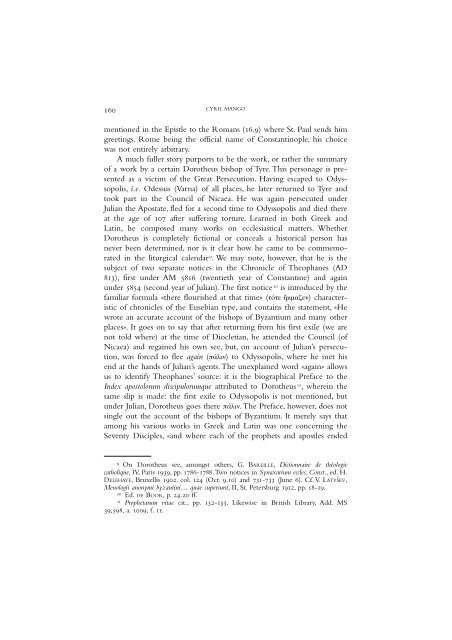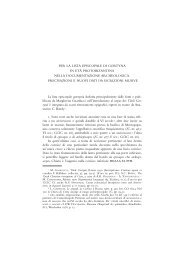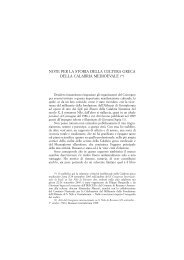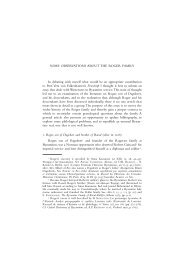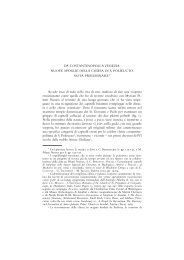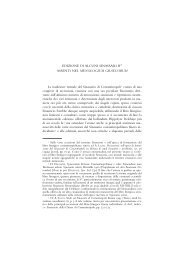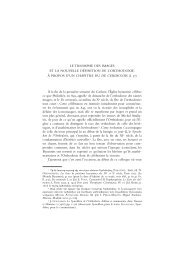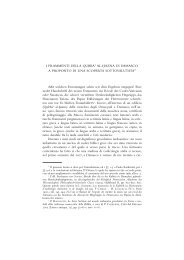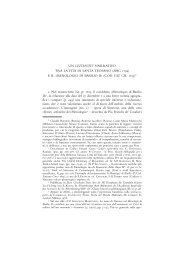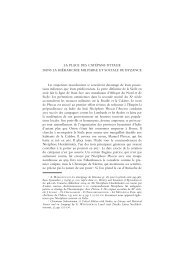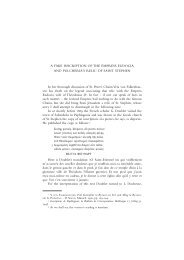CONSTANTINOPLE'S MOUNT OF OLIVES AND PSEUDO ...
CONSTANTINOPLE'S MOUNT OF OLIVES AND PSEUDO ...
CONSTANTINOPLE'S MOUNT OF OLIVES AND PSEUDO ...
Create successful ePaper yourself
Turn your PDF publications into a flip-book with our unique Google optimized e-Paper software.
160<br />
CYRIL MANGO<br />
mentioned in the Epistle to the Romans (16.9) where St. Paul sends him<br />
greetings. Rome being the official name of Constantinople, his choice<br />
was not entirely arbitrary.<br />
A much fuller story purports to be the work, or rather the summary<br />
of a work by a certain Dorotheus bishop of Tyre. This personage is presented<br />
as a victim of the Great Persecution. Having escaped to Odyssopolis,<br />
i.e. Odessus (Varna) of all places, he later returned to Tyre and<br />
took part in the Council of Nicaea. He was again persecuted under<br />
Julian the Apostate, fled for a second time to Odyssopolis and died there<br />
at the age of 107 after suffering torture. Learned in both Greek and<br />
Latin, he composed many works on ecclesiastical matters. Whether<br />
Dorotheus is completely fictional or conceals a historical person has<br />
never been determined, nor is it clear how he came to be commemorated<br />
in the liturgical calendar 9 . We may note, however, that he is the<br />
subject of two separate notices in the Chronicle of Theophanes (AD<br />
813), first under AM 5816 (twentieth year of Constantine) and again<br />
under 5854 (second year of Julian).The first notice 10 is introduced by the<br />
familiar formula «there flourished at that time» (ττε κµαεν) characteristic<br />
of chronicles of the Eusebian type, and contains the statement, «He<br />
wrote an accurate account of the bishops of Byzantium and many other<br />
places». It goes on to say that after returning from his first exile (we are<br />
not told where) at the time of Diocletian, he attended the Council (of<br />
Nicaea) and regained his own see, but, on account of Julian’s persecution,<br />
was forced to flee again (πάλιν) to Odyssopolis, where he met his<br />
end at the hands of Julian’s agents. The unexplained word «again» allows<br />
us to identify Theophanes’ source: it is the biographical Preface to the<br />
Index apostolorum discipulorumque attributed to Dorotheus 11 , wherein the<br />
same slip is made: the first exile to Odyssopolis is not mentioned, but<br />
under Julian, Dorotheus goes there πάλιν.The Preface, however, does not<br />
single out the account of the bishops of Byzantium. It merely says that<br />
among his various works in Greek and Latin was one concerning the<br />
Seventy Disciples, «and where each of the prophets and apostles ended<br />
9 On Dorotheus see, amongst others, G. BAREILLE, Dictionnaire de théologie<br />
catholique, IV, Paris 1939,pp.1786-1788.Two notices in Synaxarium eccles. Const., ed. H.<br />
DELEHAYE, Bruxellis 1902, col. 124 (Oct. 9.10) and 731-733 (June 6). Cf. V. LATYSˇEV,<br />
Menologii anonymi byzantini… quae supersunt, II, St. Petersburg 1912, pp.18-19.<br />
10 Ed. DE BOOR, p.24.20 ff.<br />
11 Prophetarum vitae cit., pp. 132-133. Likewise in British Library, Add. MS<br />
39,598, a.1009, f.1r.


